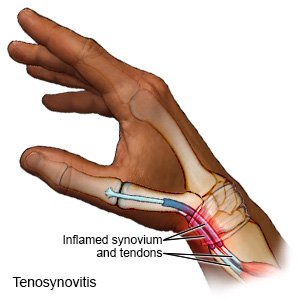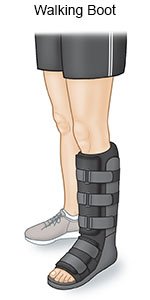Tenosynovitis
Medically reviewed by Drugs.com. Last updated on Aug 4, 2025.
Tenosynovitis is inflammation of a tendon and its synovium. Tendons are cords of tissue that connect muscles to bones. The synovium is the lining of the sheath around the tendon. The tendons may become thickened and not slide smoothly through the swollen lining.
 |
DISCHARGE INSTRUCTIONS:
Call your local emergency number (911 in the US) if:
- You have sudden trouble breathing or chest pain.
Return to the emergency department if:
- Your arm, leg, fingers, or toes are numb, tingle, or are pale.
- You hear or feel a pop in a joint.
- You have severe pain.
Call your doctor if:
- You have a fever.
- A joint near your inflamed area is red and swollen.
- Your symptoms do not go away or they get worse, even after treatment.
- You have questions or concerns about your condition or care.
Medicines:
You may need any of the following:
- Pain medicine may be needed. Do not wait until your pain is severe before you take this medicine. The medicine may not work as well at controlling your pain if you wait too long to take it. Pain medicine can make you dizzy or sleepy. Prevent falls by asking for help when you want to get out of bed.
- NSAIDs , such as ibuprofen, help decrease swelling, pain, and fever. This medicine is available with or without a doctor's order. NSAIDs can cause stomach bleeding or kidney problems in certain people. If you take blood thinner medicine, always ask your healthcare provider if NSAIDs are safe for you. Always read the medicine label and follow directions.
- Antibiotics help treat a bacterial infection.
- Antifungals help treat a fungal infection.
- Take your medicine as directed. Contact your healthcare provider if you think your medicine is not helping or if you have side effects. Tell your provider if you are allergic to any medicine. Keep a list of the medicines, vitamins, and herbs you take. Include the amounts, and when and why you take them. Bring the list or the pill bottles to follow-up visits. Carry your medicine list with you in case of an emergency.
Manage tenosynovitis:
- Rest the inflamed area as directed.
- Apply ice on your inflamed area for 15 to 20 minutes every hour or as directed. Use an ice pack, or put crushed ice in a plastic bag. Cover it with a towel. Ice helps prevent tissue damage and decreases swelling and pain.
- Elevate the inflamed area above the level of your heart as often as you can. This will help decrease swelling and pain. Prop your inflamed area on pillows or blankets to keep it elevated comfortably.
- Use your assistive device as directed. You may need a brace, splint, walking boot, or cast. You may also need to use crutches or orthotics. These devices prevent movement, decrease pain, and help your tendon heal.

- Go to physical or occupational therapy as directed. A physical therapist teaches you exercises to help improve movement and strength and decrease pain. An occupational therapist teaches you skills to help with your daily activities.
Follow up with your doctor as directed:
Write down your questions so you remember to ask them during your visits.
© Copyright Merative 2025 Information is for End User's use only and may not be sold, redistributed or otherwise used for commercial purposes.
The above information is an educational aid only. It is not intended as medical advice for individual conditions or treatments. Talk to your doctor, nurse or pharmacist before following any medical regimen to see if it is safe and effective for you.
Further information
Always consult your healthcare provider to ensure the information displayed on this page applies to your personal circumstances.
